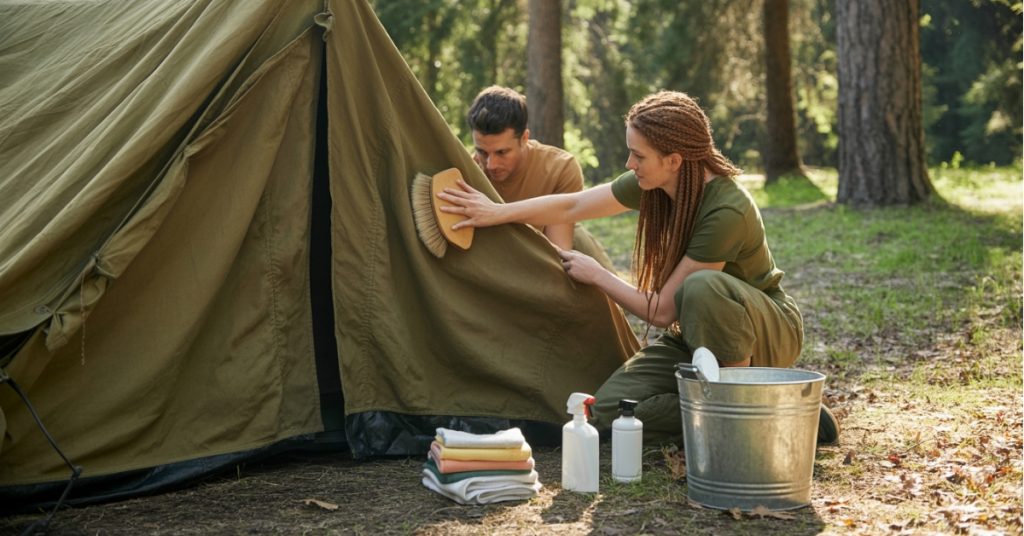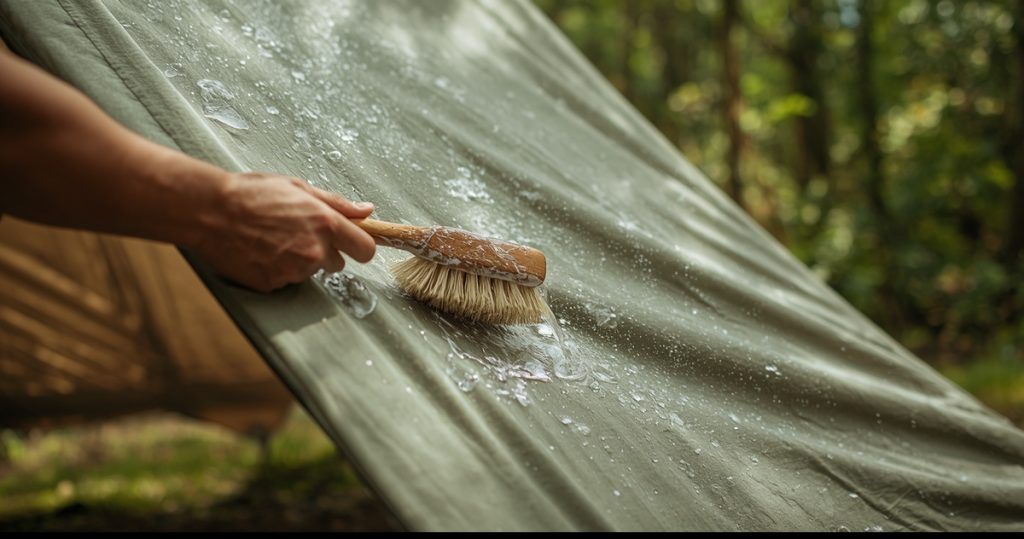As an Amazon Associate, I earn from qualifying purchases.
Canvas tents provide exceptional durability and comfort, but they require careful maintenance to preserve their performance. Unlike synthetic materials, canvas needs gentle cleaning to protect its natural fibers and waterproof treatments. Regular care is essential if you want to clean tent canvas effectively, prevent mold, mildew, and odors, and extend your tent’s lifespan while keeping it ready for every adventure.
This comprehensive guide covers everything from basic cleaning to specialized treatments for stubborn mold and mildew. You’ll also learn which products work best and discover preventive tips to clean tent canvas properly and maintain a fresh, durable tent for years to come.
Contents
Why Cleaning Your Canvas Tent Is Important

Canvas tents represent a significant investment, often lasting decades when properly maintained. However, neglecting regular cleaning can quickly degrade even the highest-quality canvas, leading to costly repairs or premature replacement.
Prevents Mold and Mildew Buildup:
Canvas is particularly susceptible to mold and mildew growth because of its natural fiber composition. These fungi thrive in damp, dirty conditions and can permanently stain your tent while creating health hazards. Once established, mold and mildew eat away at the canvas fibers, weakening the fabric structure.
Maintains Waterproofing and Breathability:
Dirt, oils, and debris clog the canvas weave, reducing its natural breathability. This trapped moisture creates condensation problems inside your tent. Additionally, accumulated grime interferes with waterproofing treatments, allowing water to penetrate areas that should remain dry.
Extends the Lifespan of the Tent Fabric:
Abrasive dirt particles act like sandpaper against canvas fibers when the tent moves in wind or during setup. Regular cleaning removes these particles before they can cause permanent damage. Clean canvas also maintains its flexibility, preventing cracking and tearing that occurs in neglected fabric.
Keeps the Tent Looking Good and Odor-Free
Nobody wants to spend their vacation in a smelly, stained tent. Regular cleaning maintains your tent’s appearance and prevents the musty odors that develop from trapped moisture and organic matter. A fresh-smelling tent enhances your camping experience and makes setup more pleasant.
How to Clean Tent Canvas: Step-by-Step Guide

Cleaning your tent canvas regularly not only preserves its durability but also ensures a comfortable and enjoyable outdoor experience. A well-maintained tent protects you from the elements, keeps you safe from potential health hazards like mold or mildew, and extends the lifespan of your camping gear. Whether you’re a seasoned camper or a weekend adventurer, investing time in proper tent care pays off by preventing costly replacements and maintaining your equipment in pristine condition for years to come.
Step 1: Set Up the Tent in a Shaded Area
Choose a location with good airflow but away from direct sunlight. UV rays can weaken wet canvas fibers, making them more susceptible to damage during cleaning. If you can’t set up the full tent, lay it flat on a clean tarp or grass surface. Ensure you have enough space to access all areas without stepping on the fabric.
Step 2: Brush Off Loose Dirt and Debris
Using a soft-bristled brush or broom, gently sweep away surface dirt, leaves, and debris. Work from top to bottom, paying special attention to seams and corners where dirt accumulates. This preliminary step prevents grinding dirt into the canvas during wet cleaning.
For stubborn debris stuck in the weave, use a vacuum cleaner with a brush attachment on low suction. Be gentle around seams and waterproof coatings to avoid damage.
Step 3: Mix Mild Soap with Lukewarm Water
Create your cleaning solution using a mild, non-detergent soap. Avoid regular laundry detergents, which contain enzymes and chemicals that break down canvas treatments. Mix one tablespoon of soap per gallon of lukewarm water in a bucket.
Specialized canvas cleaners work even better than household soap. These products are formulated specifically for natural fibers and won’t strip protective treatments from your tent.
Step 4: Gently Scrub Canvas Surfaces
Dip a clean sponge or soft cloth into your soap solution and wring out excess water. The goal is to clean without saturating the canvas. Work in small sections, using circular motions to lift dirt from the fabric.
For heavily soiled areas, use a soft-bristled brush with gentle pressure. Avoid scrubbing too vigorously, as this can damage the canvas weave or remove waterproofing treatments. Pay extra attention to high-contact areas like door flaps and guy-out points.
Step 5: Rinse Thoroughly with Clean Water
Remove all soap residue with clean water from a hose or spray bottle. Soap left in the canvas attracts dirt and can interfere with waterproofing. Rinse from top to bottom, ensuring water flows away from the tent rather than pooling underneath.
Check that rinse water runs clear before moving to the next section. Any remaining suds indicate more rinsing is needed.
Step 6: Allow Complete Air Drying
This step is crucial for preventing mold and mildew growth. Canvas must dry completely before storage, which can take 24-48 hours depending on humidity and air circulation. Position the tent to maximize airflow through all areas.
Avoid using heat sources like hair dryers or placing the tent in direct sunlight while wet. These can shrink or damage the canvas fibers. Instead, rely on natural air circulation and patience.
Step 7: Reapply Waterproofing Treatment
Cleaning may remove some of the tent’s waterproof coating, especially in high-wear areas. Once the canvas is completely dry, apply a waterproofing treatment designed for canvas tents. Follow the manufacturer’s instructions for coverage and drying time.
Test the waterproofing by sprinkling water on various areas. Water should bead up and roll off rather than soaking into the fabric.
Best Cleaning Products for Canvas Tents
When it comes to maintaining the integrity and longevity of your canvas tent, selecting the right cleaning products is crucial. High-quality cleaning products not only remove dirt, mildew, and stains but also help preserve the fabric’s durability and waterproofing properties. Look for products specifically formulated for canvas materials that are tough on grime yet gentle enough to avoid damaging the fibers or protective coatings. Opting for eco-friendly and biodegradable cleaners can also minimize environmental impact without compromising effectiveness. By choosing the best cleaning products, you ensure your tent remains in excellent condition for many adventures to come.
Mild Soap and Specialized Canvas Cleaners
Nikwax Tech Wash and Grangers Canvas Cleaner are excellent options specifically formulated for outdoor gear. These products clean effectively without damaging waterproof treatments or natural fibers.
For budget-friendly alternatives, use pure soap flakes or castile soap. These natural soaps clean gently without harsh chemicals. Avoid antibacterial soaps, which often contain additives that can harm canvas.
Proper Cleaning Tools
Invest in soft-bristled brushes designed for delicate surfaces. Car washing brushes work well, as do natural bristle scrub brushes. Avoid steel wool, abrasive pads, or stiff brushes that can tear canvas fibers.
Microfiber cloths and natural sponges provide gentle cleaning action for most surface dirt. Keep several on hand so you can use clean tools throughout the process.
Clean Water Sources
Use clean, fresh water for both washing and rinsing. Well water with high mineral content can leave deposits on canvas, while chlorinated water is generally fine for cleaning purposes.
If you’re cleaning at a campsite, ensure your water source is clean and free from sediments that could scratch the canvas.
Waterproofing Treatments
Canvas-specific waterproofing products like Thompson’s WaterSeal for Canvas or Star Brite Canvas Waterproofing maintain breathability while providing water protection. Avoid silicone-based products, which can interfere with the canvas’s natural properties.
4 Tips for Maintaining Canvas Tent Cleanliness

Maintaining the cleanliness of your canvas tent is crucial to ensure its longevity and performance during outdoor adventures. A well-cared-for tent can withstand the elements more effectively, preserving its waterproof properties and preventing mold or mildew growth. Regular cleaning, proper drying, and the use of suitable cleaning agents contribute significantly to the tent’s overall condition. By implementing these practices and storing your tent properly between uses, you not only prolong its life but also enhance your camping experience with a reliable and durable shelter.
1. Avoid Harmful Cleaning Agents
Never use bleach, harsh detergents, or enzyme-based cleaners on canvas. These chemicals break down natural fibers and remove protective treatments permanently. Similarly, avoid fabric softeners, which can interfere with waterproofing.
Acidic cleaners like vinegar can weaken canvas fibers over time, despite being natural. Stick to pH-neutral soaps for regular cleaning.
2. Establish Regular Cleaning Schedules
Clean your canvas tent after every 3-4 camping trips, or immediately after exposure to mud, sand, or salt water. Don’t wait for visible dirt buildup, as embedded particles become harder to remove over time.
Quick spot cleaning during trips prevents small stains from setting permanently. Pack a small brush and mild soap for field maintenance.
3. Proper Storage Techniques
Always store your tent completely dry in a cool, well-ventilated area. Roll rather than fold the canvas to prevent permanent creases that can crack over time. Use breathable storage bags rather than plastic, which traps moisture.
Check stored tents every few months for signs of mold, mildew, or pest damage. Early detection prevents minor issues from becoming major problems.
4. Address Problems Promptly
Repair small tears, loose seams, or damaged grommets immediately. These issues worsen quickly and can lead to major repairs if ignored. Keep a tent repair kit with canvas patches and seam sealer for quick fixes.
For significant damage or persistent mold problems, consult professional tent repair services rather than attempting complex repairs yourself.
Dealing with Mold and Musty Odors

Mold and musty odors are common issues that occur when a tent is stored improperly or put away while still damp. These problems not only cause unpleasant smells but can also weaken the fabric and reduce the longevity of your tent. Addressing these issues promptly and thoroughly is crucial to maintaining a clean and functional tent for your outdoor adventures. With the right approach, it’s possible to eliminate mold, remove odors, and restore your tent to a pristine condition.
Identifying Mold and Mildew
Mold appears as black, green, or brown spots on canvas, while mildew typically shows as gray or white powdery patches. Both create musty odors and can cause health problems if not addressed promptly.
Check inside seams, corners, and areas where the tent contacts the ground most carefully, as these spots retain moisture longest.
Safe Mold Removal Process
For minor mold spots, create a solution of equal parts water and white vinegar. Apply with a spray bottle and let sit for 30 minutes before gentle scrubbing. The acid in vinegar kills mold spores without damaging canvas when used sparingly.
For extensive mold problems, use a specialized canvas cleaner with anti-fungal properties. Follow up with thorough rinsing and complete drying to prevent immediate regrowth.
Eliminating Musty Smells
Musty odors often persist even after visible mold removal. To get musty smell out of tent canvas, create a baking soda paste with water and apply to affected areas. Let it sit for several hours before brushing away and rinsing thoroughly.
Ensure complete drying and consider UV treatment by letting the clean, damp canvas sit in indirect sunlight for a few hours. UV rays help break down odor-causing compounds naturally.
Caring for Your Investment
Proper canvas tent maintenance protects your investment while ensuring years of comfortable camping experiences. The gentle cleaning methods outlined here preserve your tent’s natural properties while removing harmful contaminants.
Remember that patience is key when cleaning canvas. Rushing the process or using harsh methods can cause permanent damage that’s expensive to repair. Take time to clean thoroughly and dry completely, and your canvas tent will reward you with decades of reliable service.
Regular maintenance combined with proper storage creates a cycle of care that keeps your tent looking good and performing well. Start implementing these practices after your next camping trip, and you’ll notice the difference in your tent’s appearance and longevity.
Final Verdict
Proper cleaning and maintenance of your canvas tent are essential for preserving its durability, waterproofing, and overall performance. By following gentle cleaning methods, addressing mold or mildew promptly, and using suitable products, you not only extend the life of your tent but also ensure a comfortable, odor-free camping experience. Regular care, combined with proper storage and timely repairs, protects your investment and keeps your canvas tent adventure-ready for many years to come.
Frequently Asked Questions
Can I machine wash my canvas tent?
No, never machine wash a canvas tent. The agitation and harsh detergents in washing machines can damage canvas fibers, remove waterproofing, and cause shrinkage. Always hand wash canvas tents using gentle methods.
How often should I clean my canvas tent?
Clean your canvas tent after every 3-4 camping trips, or immediately after exposure to mud, sand, salt water, or tree sap. If musty odors or visible dirt appear, clean the tent before your next trip regardless of the last cleaning.
Will cleaning remove waterproofing from canvas?
Gentle cleaning with appropriate products shouldn’t significantly remove waterproofing. Repeated or harsh cleaning can gradually reduce effectiveness. Always test water beading after cleaning and reapply waterproofing as needed.
Can I use bleach or strong detergents on canvas?
Never use bleach, harsh detergents, or enzyme-based cleaners. These chemicals break down natural fibers and permanently remove protective treatments. Stick to mild soaps or specialized canvas cleaners.
How do I remove mold or mildew from canvas?
For minor mold, use a solution of equal parts water and white vinegar. Apply, let sit 30 minutes, then gently scrub and rinse thoroughly. For extensive mold, use specialized anti-fungal canvas cleaners. Always dry completely to prevent regrowth.
As an Amazon Associate, I earn from qualifying purchases.
